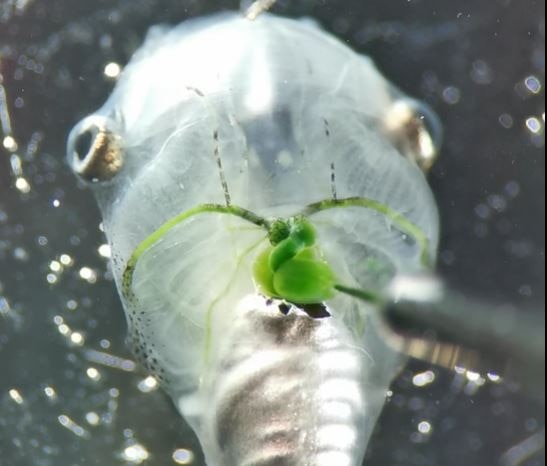Create a free profile to get unlimited access to exclusive videos, sweepstakes, and more!
It's not easy being green. Injected and illuminated algae breathes for tadpoles
Who needs lungs when you have plants?

You probably don’t often think about it, but getting oxygen to the various tissues of your body is priority number one if you want to keep being alive. Most of the time that isn’t a problem. Atmospheric oxygen is present all around us, and we take it in without even being aware of it. There are some potential pitfalls in our design, however. Our breathing hole is located nefariously close to our eating hole. Some environments we might want to explore, like deep in the ocean or at higher altitudes, offer insufficient oxygen. And diseases or injury can disrupt easy access to these life-giving molecules. But what if, like some sea sponges and corals, we didn’t have to breathe at all?
That’s the question Suzan Özugur, PhD student in the Division of Neurobiology at Ludwig Maximilian University, and colleagues set out to answer. They were able to use photosynthetic algae, transfused into the vascular system of tadpoles, to take the place of normal respiration. Their results are published in the journal iScience.
The team took inspiration from animals like corals which have a symbiotic relationship with algae, utilizing the plant’s natural photosynthetic ability to capture oxygen for their own use. To test their hypothesis, translucent tadpoles were place in an oxygen deficient ringer solution until neural activity completely stopped. Then algae was injected into the vascular system and illuminated to stimulate photosynthesis. It worked.
“We injected the algae into the tadpole’s heart and let them pump through the vasculature by their normal heart rate,” Özugur told SYFY WIRE. “The algae were delivered through the vasculature, even reaching the brain. Then with illumination the algae produce oxygen. We saw the nerve activity coming back. Simply by turning the light on and off it was sufficient to restore nerve activity.”
In essence, the algae took the place of blood cells for tissue oxygenation. In fact, there was no blood flow in the tadpoles, the algae circulated to their tissues, delivering oxygen directly to the cells. There was no longer any need to breathe, which was good, as there was no atmospheric oxygen available.
This process offers a potential alternative therapy in instances where people have disrupted oxygen delivery, so long as the vascular system is intact. The team imagined scenarios, like respiratory disease in which the lungs could cut out of the equation entirely. In tadpoles, the process was helped along by their transparent skin. Sufficient light was able to reach the algae through the skin. Of course, that wouldn’t be the case in other animals like humans, but they’re already thinking of workarounds.
“We could use an electrode or a thin light to illuminate the regions where oxygen production is needed. If you have active blood flow, it might be possible to activate the algae in one place and deliver oxygen all over your body,” Özugur said.
As with any transplanted or transfused material, it’s important to make sure there won’t be any unwanted interactions in the body. In typical medical procedures, that means matching tissue types between donor and recipient and using immunosuppressant drugs to prevent rejection. Surprisingly, that doesn’t seem to be an issue with algae. While the experiments were relatively short-lived, on the order of a few hours at a stretch, there was no indication of rejection or attack from the body’s defenses.
“There was no immune response that we could detect,” Özugur said. “We need to do long term experiments to see if there’s really no immune reaction. However, there have been other experiments with zebrafish and there was no immune response there either. Other experiments used the same algae to create skin grafts for wound recovery and there was also no immune response. It might be that this kind of algae is quite good for transplantation or injection.”
In addition to having no ill reaction in the recipient body, the algae also seemed to do well. During the course of the experiment, there was no indication that the algae died in the body of the tadpoles. This may relate to the already existing symbiotic relationships present in nature. These algae appear not to need much to survive inside another organism. “For long term use we can think of replacing them or supporting them with necessary ions or growth factors so they can produce more oxygen and reproduce,” Özugur said.
The future of mountain climbing, scuba diving, medicine, and space exploration might be a bit greener. If we’re lucky, a newfound friendship with algae might have us all breathing a little easier. Or, bizarrely enough, no breathing at all



























